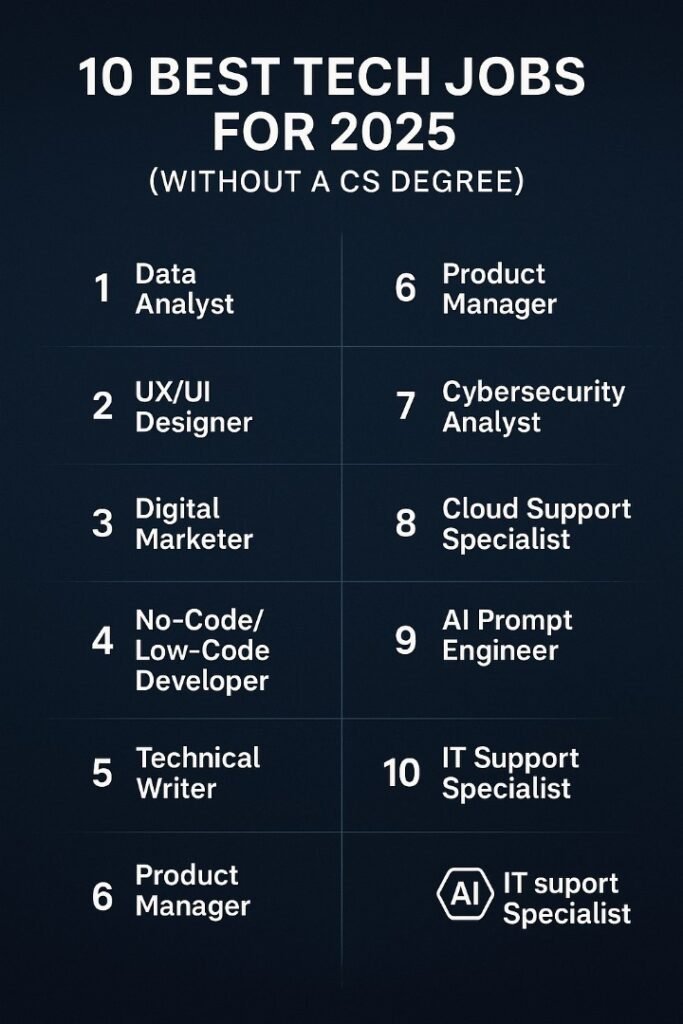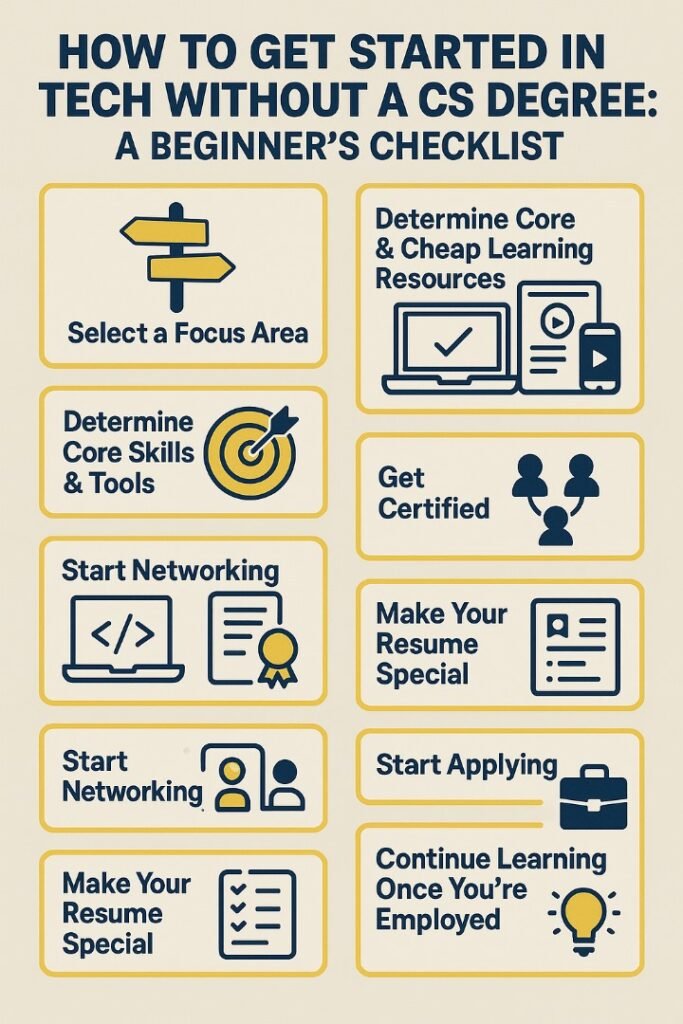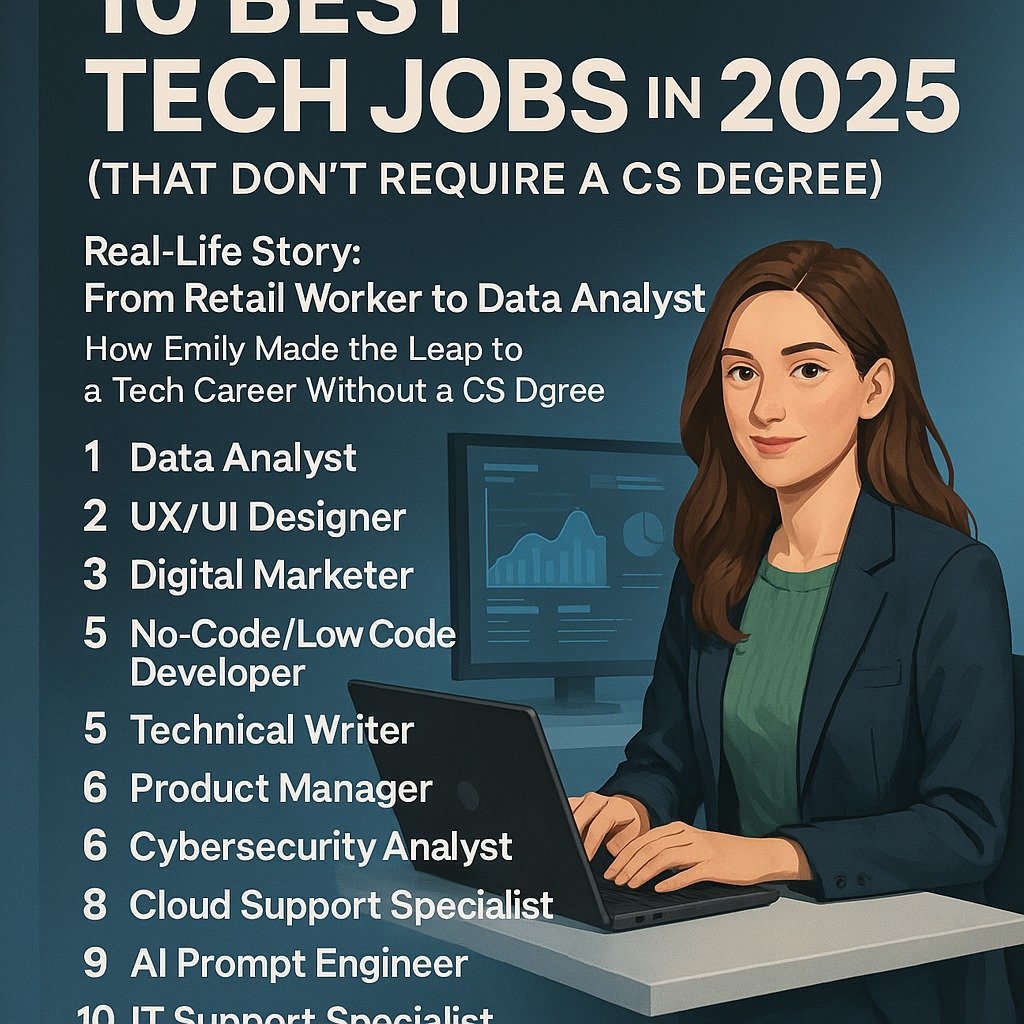
Real-Life Story: From Retail Worker to Data Analyst – How Emily Made the Leap to a Tech Career Without a CS Degree
Emily had worked retail for years. She woke up early, worked long days, and just managed to get by. While the individuals she worked with were pleasant, and it paid the bills, Emily felt like there was always something more. She was working hard, but she did not feel fulfilled. The idea of entering a career where she could make a difference and earn a better paycheck seemed like a fantasy. She continually had herself looking at technology careers but ruled them out, thinking that they were for computer science majors.
It was one ordinary day when Emily was mindlessly perusing social media feed, and her gaze caught onto a free course advertisement on data analysis for the internet. Emily had always been interested in how numbers and data tell stories, so the advertisement piqued her interest. It became a spark.
At first, Emily was a little unsure of herself. She had no knowledge of any technology, and data was scary. But, something was different. She wanted to give the course a try. She signed up, knowing she did not know where it would take her, but was willing to try the first step.
The First Steps: Learning the Basics
Emily started with baby steps, applying about an hour a day after work, to studying data analysis. Her first focus was Excel, which she thought would be a viable starting point. Within a few weeks, Emily felt she was gaining some aptitude. She learned to create simple spreadsheets, and even analyze data trends.
Then, she learned SQL (structured query language) as a query language to access databases. Emily struggled to get her head around it, but that did not stop her. She was able to break her learning up into segments, and practice every day. And, over time, she started to see the connection between SQL and the Excel skills she had already gained. The pieces began to fit together.
Once Emily felt at ease with SQL, she went on to learn Python, which is heavily utilized in data analysis. Python was harder, but Emily loved how much she could do with Python! Emily loved the fact that she could automate work processes, analyze large data, and visualize. She was starting to feel momentum build.
Creating a Portfolio: From Theory to Application
Now that Emily was growing in confidence in her skills, she also realized she would have to create a portfolio to showcase her work. She started applying her new skills to real projects. At first, she was working with simple datasets she had found online, like examining sales numbers for a fictional retail company or conducting market research for a neighborhood coffee shop. The projects weren’t glamorous, but they were real-world, and they helped her solidify her learning.
In a matter of months, Emily’s portfolio was complete. She documented it all—her projects, the code she wrote, and what she learned—and uploaded it to GitHub. She created a personal site as well to showcase her work. Every project was a testament to her hard work and evolving skill set.
Meanwhile, Emily also completed her certification in data analytics through Coursera. It wasn’t a degree, but it was confirmation that she possessed the skills required to succeed in the career. This added the confidence she needed to take the next step: job searching.
The Job Hunt: Persistence Pays Off
The job search was not easy. Emily knew that she was up against seasoned people with traditional degrees, but she did not give up. She customized her resume so that she highlighted her portfolio and the specific skills she had acquired, rather than labeling herself as non-degree holder. She applied for dozens of jobs each week and typically heard nothing.
But Emily wasn’t deterred by rejection. With every application, she gained something new about what employers were looking for. She refined her resume, practiced her interview, and kept networking on LinkedIn. Emily found online communities of data analysts and tech enthusiasts, and connected with people experiencing the same things.
And then one day it happened. Emily received an interview invite from a tech company looking for a junior data analyst. She was anxious, but she was also thrilled. During the interview, she discussed her portfolio, the projects she had done, and how she had learned the skills needed for the job. Her enthusiasm for data and her willingness to learn were evident.
A week after, Emily received her first job in the tech industry. She was in shock. The salary was not only higher than her retail work but also had the potential to increase and contribute to an industry she adored. Emily’s hard work, determination, and eagerness to learn had finally been rewarded.
The Transformation: A New Career, A New Life
Currently, Emily is a data analyst in a fast-growing technology firm. She spends her days at work working with large datasets, helping her colleagues make informed decisions based on data, and creating visualizations that have a compelling narrative. Though she has far more to learn, Emily has never been more confident. She’s always leveling up, attending workshops, and contributing to open-source projects to widen her skills.
What’s most rewarding to her, however, is the sense of fulfillment and purpose she now feels in her work. Emily is no longer tied to a job she doesn’t love. Her successful path from retail worker to data analyst shows us that you can break into the tech field without a computer science degree — provided you’re motivated to do the work!
Her story is one of action, grit, and the belief that anyone could succeed in tech with the right tools and mindset. If Emily can do it, so can you. Do not let a lack of degree hold you back — if you take that first step, you’ll probably be well on your way to a fulfilling and lucrative tech career!
Introduction
The current day is now 2025 and the tech industry is advancing at an unprecedented pace—and the door is wide open for people from all backgrounds. You no longer need a computer science degree to find a great tech job that pays really well and has real meaning. The old gatekeepers are losing power as hiring based on skills is becoming norm.
Whether you are a student, a stay at home mom or dad, a worker at a retail or restaurant, or just that person that is in a job you don’t love there is a way into tech that does not require four years of college or tens of thousands of dollars in tuition. With self-paced learning sites, real projects to work on, and consistent growth in hiring of tech talent, employers are hiring based upon your abilities and not where you graduated.
In this post we will discuss the 10 best tech jobs for 2025 if you do not have a CS degree, what skills you need to get that job, and how to get started—even if you’re starting at zero.
Why It’s in Demand: Organizations are drowning in data but starved for insight. Data analysts help make data meaningful to make informed, smart decisions.
Skills Needed:
1.Excel or Google Sheets
2.SQL
3.Python or R
4.Tableau or Power BI
Critical thinking and storytelling with data
How to Learn: Coursera online courses, DataCamp, or free learning materials such as Kaggle.
Average Salary: $70,000–$100,000
Why It’s in Demand: Since sites and applications continue to go mobile, UX/UI designers play an essential part in creating flawless, intuitive interactions.
Skills Required:
1.Design tools: Figma, Adobe XD, Sketch
2.Essential HTML/CSS
3.Wireframing & prototyping
User research
Where to Learn: Bootcamps like CareerFoundry or learning platforms like Interaction Design Foundation.
Average Wage: $75,000–$110,000
Why It’s in Demand: Online visibility is in vogue these days. Online campaigners use tactics and tools to perfect online processes and customer interactions.
Skills Required:
1.SEO/SEM
2.Google Analytics & Search Console
3.Content marketing
4.Social media strategy
How to Learn: Google Digital Garage, HubSpot Academy, or Udemy.
Average Salary: $60,000–$90,000
Why It’s in Demand: Companies and startups require solutions fast without hefty engineering teams. No-code allows them to do it.
Skills Needed:
1.Tools like Bubble, Webflow, Glide
2.Simple logic & workflows
3.API integrations
How to Learn: YouTube tutorials, Makerpad, or courses on Udemy.
Average Salary: $65,000–$95,000
Why It’s in Demand: All tech companies need well-documented stuff—for users and developers.
Skills Needed:
1.Writing & editing
2.General knowledge of tech stacks
3.Tools like Markdown, Notion, Confluence
How to Learn: Start by writing on Medium, or learn through technical communication courses.
Average Salary: $70,000–$100,000
6. Product Manager
Why It’s in Demand: They occupy a vantage point of engineering, business, and design to create more value.
Skills Required:
1. Communication & collaboration
2.Agile methodologies
3.Market research
4.JIRA, Asana, Trello
Where to Learn: Inspired by Marty Cagan, a book, or courses at Product School.
Average Salary: $90,000–$130,000
7. Cybersecurity Analyst
Why It’s in Demand: As cyber threats rise, businesses require experts to protect digital assets.
Skills Needed:
1.Network fundamentals
2.Security tools (like Wireshark, Splunk)
3.Risk assessment
4.Ethical hacking basics
How to Learn: CompTIA certification or courses in Cybrary, IBM SkillsBuild.
Average Salary: $85,000–$120,000
8. Cloud Support Specialist
Why It’s in Demand: Cloud is on a peak point. Cloud use is a universal practice for everyone now.
Skills Needed:
1.AWS, Azure, or Google Cloud
2.Linux/command line basics
3.Networking concepts
How to Learn: AWS Skill Builder, Google Cloud learning, or LinkedIn Learning.
Average Salary: $75,000–$110,000
9. AI Prompt Engineer
Why It’s in Demand: As tools like ChatGPT and Claude become mainstream, prompt engineers shape outputs with smart inputs.
Skills Needed:
1.Solid language & logic skills
2.Familiarity with LLMs (Large Language Models)
3.Tools like ChatGPT, Anthropic Claude, Midjourney
How to Learn: Practice prompt engineering, follow X (formerly Twitter) experts, or learn specialist courses on Udemy.
Average Salary $100,000–$150,000
10. IT Support Specialist
Why is it in demand: They keep company systems up and running, troubleshoot, and support hardware/software.
Skills Needed:
1. Problem-solving
2. OS knowledge (Windows, macOS, Linux)
3. Remote support tools (TeamViewer, Zoom…….)
How to get started: Google IT Support Certificate, CompTIA A+.
Expected Salary: $50,000–$80,000
How to Get Started in Tech Without a CS Degree: A Beginner’s Checklist
Becoming a tech-breaker in 2025 without a traditional computer science degree might seem impossible—but it’s totally doable with the proper roadmap. Below is an extended beginner’s checklist to guide your path step-by-step.
- Select a Focus Area (and Commit to It for 90 Days)
Pick a path—such as UX/UI design, cloud support, or digital marketing. Do not change tracks week by week. Spend 90 days studying and working in that field before changing again.
Use free career guidance resources or read day-in-the-life blogs to determine what role is the most interesting to you.
- Determine Core Skills & Tools for the Job
Take a brief scan of top skills and tools needed in your career option. You can conveniently check out the job advertisements on Indeed or LinkedIn.
Create a basic roadmap: For example, if you are stepping into data analysis, your roadmap could be like:
Month 1: Excel + SQL Basics
Month 2: Python (pandas, matplotlib)
Month 3: Visualization tools + Portfolio project
Apply this template for any profession to stay on course.
- Leverage Free & Cheap Learning Resources
Learning no longer has to be expensive. Combine formal courses with hands-on learning:
Free Sites: FreeCodeCamp, CS50 from Harvard, The Odin Project
Cheap Courses: Udemy, Skillshare, Coursera (typically under $20 when they’re discounted)
YouTube Channels: Traversy Media, NetworkChuck, TechWithTim
Be sure to put into practice what you learn in real-world projects—don’t just sit back and watch videos.
- Build Actual Projects (Even If Self-Imposed)
The best way to prove your skills without a degree? Make something. Anything.
Ideas:
Duplicate a well-known app (Airbnb, Twitter, etc.)
Build a personal site/portfolio
Code a task in Python
Build a UX case study for a local business website
Put it all on GitHub, Notion, or a simple blog. Employers like to see work, not certificates.
- Get Certified to Establish Credibility
Certifications are not necessary but worth it—especially if you’re starting from scratch.
Best entry-level certs:
Google IT Support or UX Design Certificate
AWS Cloud Practitioner
CompTIA A+
HubSpot Digital Marketing Certification
These show dedication and a general understanding of the subject.
- Start Networking (Even if New)
Engage in online discussions and chat with people. Many will help you if you approach them directly.
Places to network:
LinkedIn (leave comments on posts, attend events)
Discord servers (like Learn AI Together or 100Devs)
Reddit (r/learnprogramming, r/techcareers)
Hint: Be transparent about your learning process. Update weekly blog progress on LinkedIn or Twitter. It builds credibility and attracts mentors.
- Make Your Resume Special (Even With No Experience)
Highlight transferable skills—communication, leadership, or problem-solving. Highlight what you can do on your resume:
Link your projects
Add certifications
Employ action verbs (“Developed,” “Designed,” “Analyzed”)
You can use Rezi or Jobscan as tools to optimize your resume for applicant tracking systems (ATS).
- Start Applying (Before You Feel 100% Ready)
Far too many people take too long before they start job searching. The truth is, you’re going to learn a lot along the way through the process of applying.
Set a target: apply to 5–10 jobs per week. Don’t let rejection get you down—use it to improve your resume, cover letter, or interviewing skills.
- Continue Learning Once You’re Employed
Once you have your first technology job, learning doesn’t stop. Upskill on a regular basis to broaden your job and income.
How to upgrade:
Go to workshops
Get involved in open-source
Monitor industry trends through blogs and newsletters
Technology changes quickly—those who stay adaptable succeed best.

Final Thoughts
Getting into the tech industry without a computer science degree is fully achievable, and likely more rare than you think. There will be many lucrative, competitive technology careers in 2025 (as we’ve listed in this post) that do not require a traditional, computer science degree. If you possess the willingness to learn and adjust to the fast-paced world of technology, anyone can find a role in technology, whether a data analyst, cloud support technician, or something else altogether!
Emily’s journey from retail clerk to data analyst is testament to the fact that with hard work, dedication, and access to the proper tools, anyone can transition into the tech industry. Her story showcases the power of online learning, a strong portfolio, and networking—actions available to anyone entering the field.
Although it may not be the straightest route to a successful career in technology, you do have the skills that you need to get started. There are plenty of free or inexpensive resources where you can find support to learn, from platforms like Coursera, Udemy, or Youtube or find a community online that will help you learn from those who are already working in the industry.
Education is secondary to skills in the technology industry, and with a good attitude, you can develop the skills that will make you a success in the careers that build the future. If you want to pursue UX/UI design, digital marketing, or AI engineering, your passion and dedication will be your greatest assets when you begin your tech career.
So take the first step today. Choose a path, begin learning, and above all else, keep building—because with perseverance, adaptability, and a dedication to continuous learning, the best tech careers of 2025 are within your reach.
